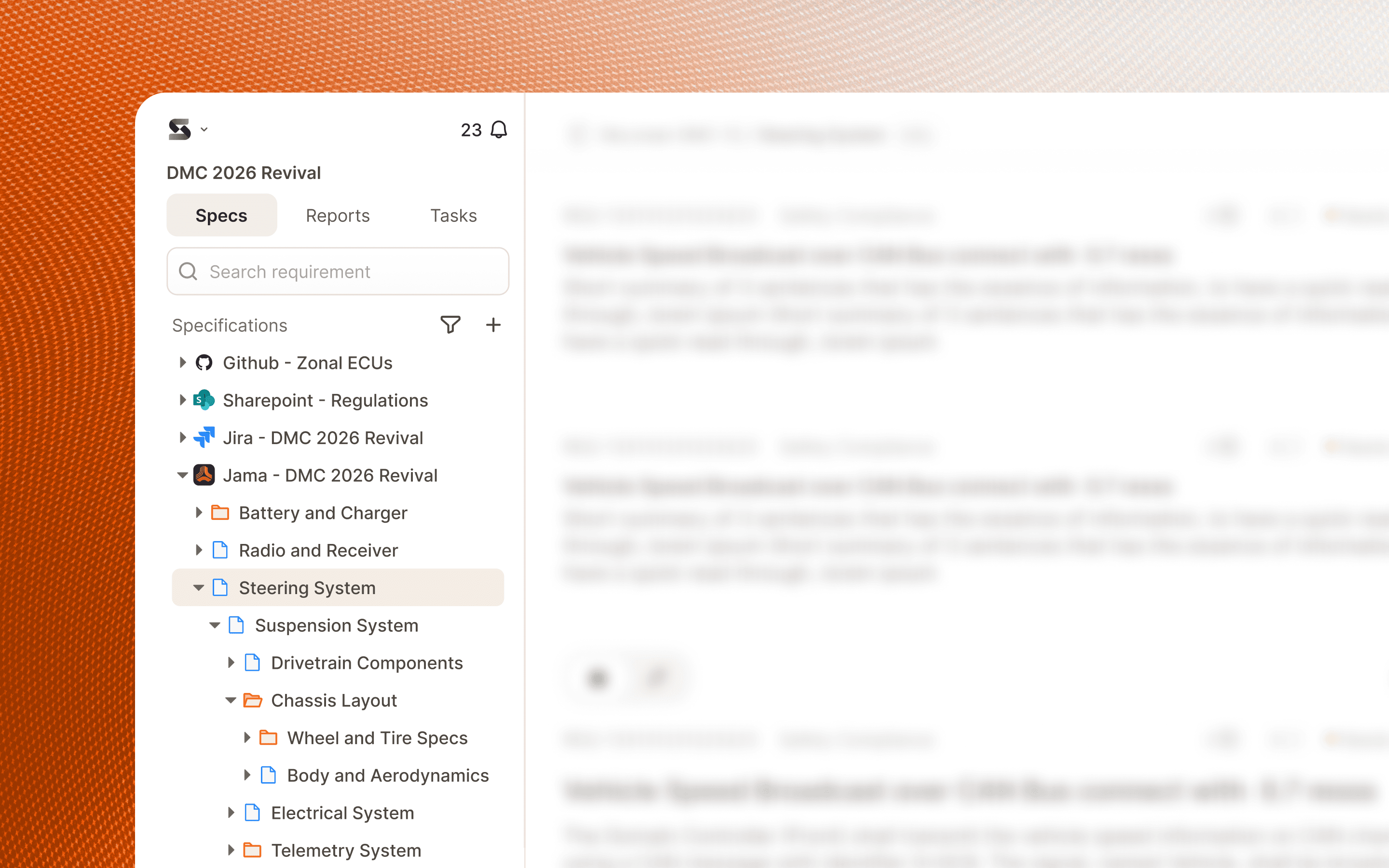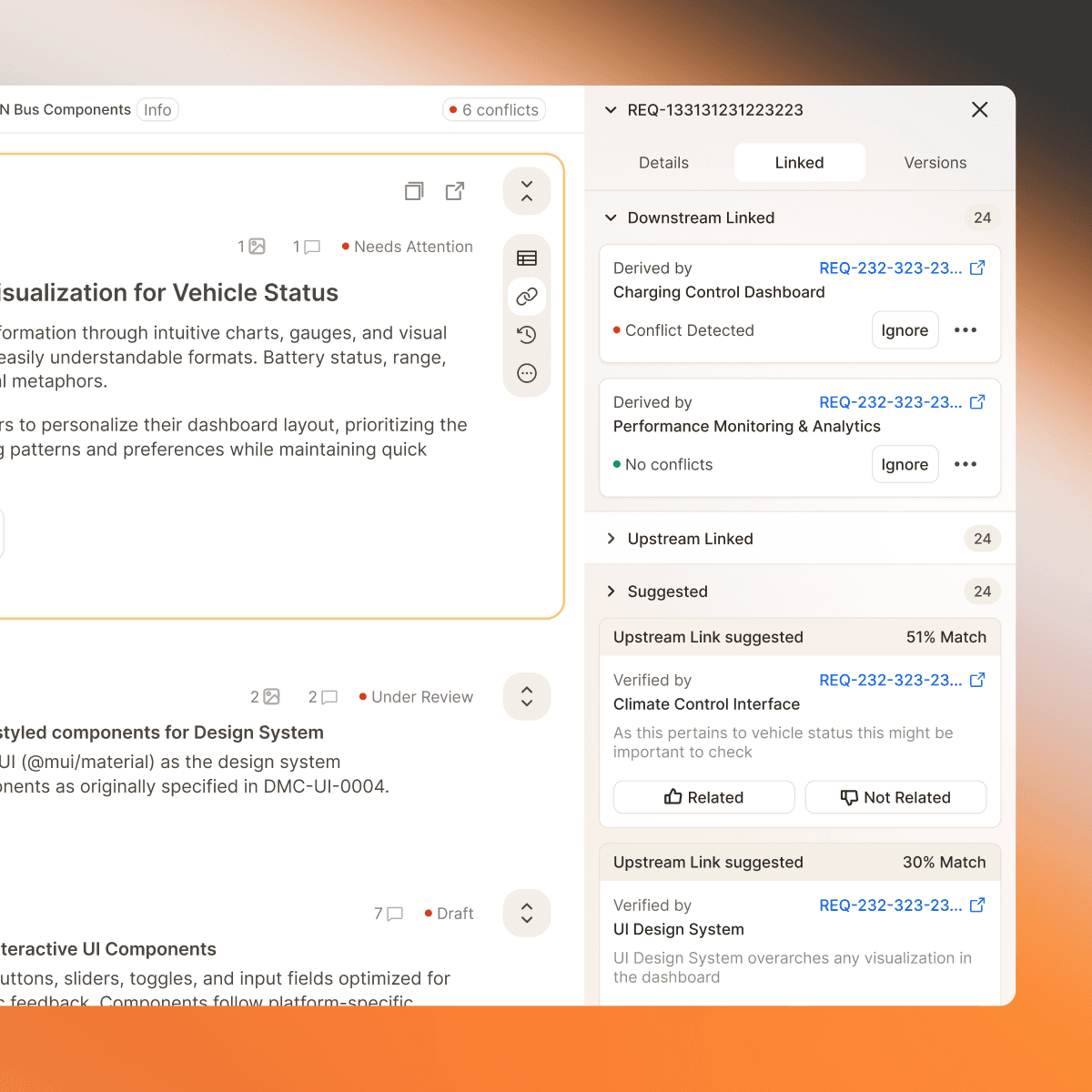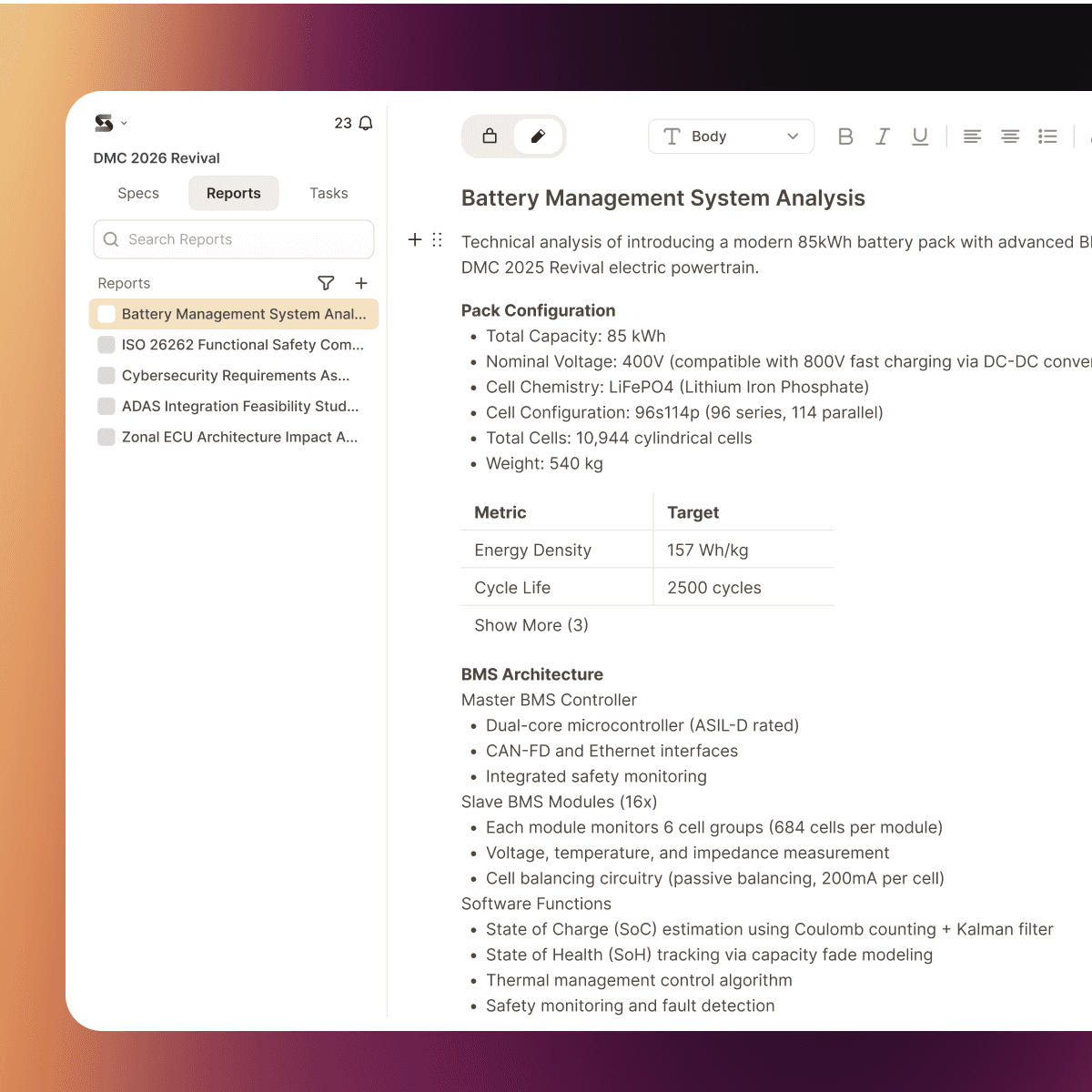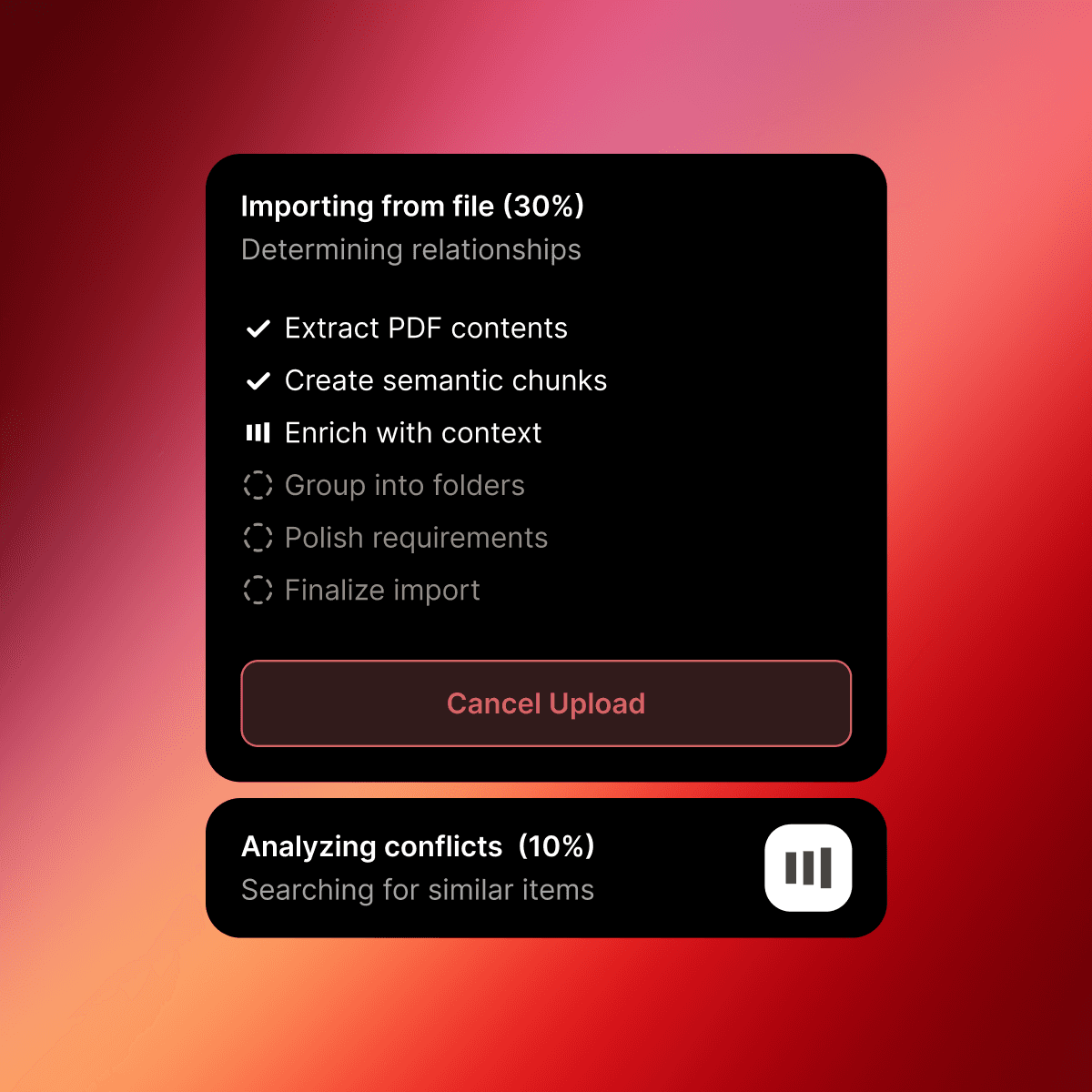Specvia empowers engineers with AI muscle to help find, trace and validate progress; from concept to compliance.
Specvia empowers engineers with AI muscle to help find, trace and validate progress; from concept to compliance.
Engineering
Specvia empowers engineers with AI muscle to help find, trace and validate progress; from concept to compliance.
The
for Engineers
Interactive, agentic and collaborative experience to help you do more with less
Connect your sources
Bring requirements, configs, source code, standards from your existing tools.
Define Agents
Teams specify rules and tools that define agents who take action on their behalf.
Manage Inferences
Work with agents to identify gaps, speculate issues and collaborate for fixes.

The
for Engineers
Interactive, agentic and collaborative experience to help you do more with less
Connect your sources
Bring requirements, configs, source code, standards from your existing tools.
Define Agents
Teams specify rules and tools that define agents who take action on their behalf.
Manage Inferences
Work with agents to identify gaps, speculate issues and collaborate for fixes.

The
for Engineers
Interactive, agentic and collaborative experience to help you do more with less
Connect your sources
Bring requirements, configs, source code, standards from your existing tools.
Define Agents
Teams specify rules and tools that define agents who take action on their behalf.
Manage Inferences
Work with agents to identify gaps, speculate issues and collaborate for fixes.

Meet your own Agents
Starting at $399/month

Configuration Manger
Keep system stable and versions in sync across environment
$ 11,250/month

Requirements Engineer
Helps establish traceability, spot conflicts and suggest fixes.
$ 9,500/month

Product Owner
Prioritizes backlog, maximizes product value and consistency.
$ 10,000/month

Quality Analyst
Validates, and ensures compliance with running scope.
$ 7,000/month

CyberSecurity Analyst
Guards systems against cyber security threat catalog.
$ 10,400/month

Custom
Agent
Add your roles and tools to setup an agent tailored to your workflow.
Talk to team
Meet your own Agents
Starting at $399/month

Configuration Manger
Keep system stable and versions in sync across environment
$ 11,250/month

Requirements Engineer
Helps establish traceability, spot conflicts and suggest fixes.
$ 9,500/month

Product Owner
Prioritizes backlog, maximizes product value and consistency.
$ 10,000/month

Quality Analyst
Validates, and ensures compliance with running scope.
$ 7,000/month

CyberSecurity Analyst
Guards systems against cyber security threat catalog.
$ 10,400/month

Custom
Agent
Add your roles and tools to setup an agent tailored to your workflow.
Talk to team
Meet your own Agents
Starting at $399/month

Configuration Manger
Keep system stable and versions in sync across environment
$ 11,250/month

Requirements Engineer
Helps establish traceability, spot conflicts and suggest fixes.
$ 9,500/month

Product Owner
Prioritizes backlog, maximizes product value and consistency.
$ 10,000/month

Quality Analyst
Validates, and ensures compliance with running scope.
$ 7,000/month

CyberSecurity Analyst
Guards systems against cyber security threat catalog.
$ 10,400/month

Custom
Agent
Add your roles and tools to setup an agent tailored to your workflow.
Talk to team

🧑
🤖

🧑
🤖

🧑
🤖
Semantic Embedding
Built-in Dynamic Traceability
Link upstream rationale with downstream outcomes to maintain a continuous, auditable chain of traceability
Know exactly what’s affected when requirements change.
Adapt specs and tests in real-time without breaking trace
Automatically generate a traceable history for regulators.
Realtime embedding to surface similar items
Reduced ambiguity for stakeholders






Graph RAG
Reason with
Deep Analysis
Actionable reports that explain what changed and why.
Reports enriched with deep reasoning that show each requirement and its dependencies
Replaces static summaries with context-rich insights to make impact easy to understand
Quickly identify affected items and prioritize the highest-risk changes
Makes change management, impact analysis, and status tracking faster and more confident






AI Pipelines
Context driven
Intelligent Actions
Turn any input into structured, actionable intelligence.
Requirements are grouped, classified, and prioritized into meaningful folders without any manual sorting.
AI polishes draft text, generates titles, and surfaces relationships for clearer, more consistent requirements.
Every action considers related discussions, history, and dependencies for smarter guidance and conflict detection.
Background workers handle imports, analysis, enrichment, and notifications to free up users.






Semantic Embedding
Built-in Dynamic Traceability
Link upstream rationale with downstream outcomes to maintain a continuous, auditable chain of traceability
Know exactly what’s affected when requirements change.
Adapt specs and tests in real-time without breaking trace
Automatically generate a traceable history for regulators.
Realtime embedding to surface similar items
Reduced ambiguity for stakeholders
Graph RAG
Reason with
Deep Analysis
Actionable reports that explain what changed and why.
Reports enriched with deep reasoning that show each requirement and its dependencies
Replaces static summaries with context-rich insights to make impact easy to understand
Quickly identify affected items and prioritize the highest-risk changes
Makes change management, impact analysis, and status tracking faster and more confident
AI Pipelines
Context driven
Intelligent Actions
Turn any input into structured, actionable intelligence.
Requirements are grouped, classified, and prioritized into meaningful folders without any manual sorting.
AI polishes draft text, generates titles, and surfaces relationships for clearer, more consistent requirements.
Every action considers related discussions, history, and dependencies for smarter guidance and conflict detection.
Background workers handle imports, analysis, enrichment, and notifications to free up users.






Semantic Embedding
Built-in Dynamic Traceability
Link upstream rationale with downstream outcomes to maintain a continuous, auditable chain of traceability
Know exactly what’s affected when requirements change.
Adapt specs and tests in real-time without breaking trace
Automatically generate a traceable history for regulators.
Realtime embedding to surface similar items
Reduced ambiguity for stakeholders
Graph RAG
Reason with
Deep Analysis
Actionable reports that explain what changed and why.
Reports enriched with deep reasoning that show each requirement and its dependencies
Replaces static summaries with context-rich insights to make impact easy to understand
Quickly identify affected items and prioritize the highest-risk changes
Makes change management, impact analysis, and status tracking faster and more confident
AI Pipelines
Context driven
Intelligent Actions
Turn any input into structured, actionable intelligence.
Requirements are grouped, classified, and prioritized into meaningful folders without any manual sorting.
AI polishes draft text, generates titles, and surfaces relationships for clearer, more consistent requirements.
Every action considers related discussions, history, and dependencies for smarter guidance and conflict detection.
Background workers handle imports, analysis, enrichment, and notifications to free up users.



Explore our key features
Driving engineering excellence
Explore our key features
Driving engineering excellence
Collaborate with Agents
Interact with agents as you would with other humans enabling limitless human-in-loop AI.
Collaborate with Agents
Interact with agents as you would with other humans enabling limitless human-in-loop AI.
Collaborate with Agents
Interact with agents as you would with other humans enabling limitless human-in-loop AI.
Stakeholder modelling
Re-model any data based on stakeholder profiles to be more relavent to their context.
Stakeholder modelling
Re-model any data based on stakeholder profiles to be more relavent to their context.
Stakeholder modelling
Re-model any data based on stakeholder profiles to be more relavent to their context.
API First Design
Support for MCP and A2A to integrate and future proof against other AI workflows.
API First Design
Support for MCP and A2A to integrate and future proof against other AI workflows.
API First Design
Support for MCP and A2A to integrate and future proof against other AI workflows.
Convert Code to Specifications
Transform commits to requirements and allow tracability to follow through implementation.
Convert Code to Specifications
Transform commits to requirements and allow tracability to follow through implementation.
Convert Code to Specifications
Transform commits to requirements and allow tracability to follow through implementation.
Import PDFs and files
Limitless ingestion of external data formats such as customer inputs, regulations and standards as requirements.
Import PDFs and files
Limitless ingestion of external data formats such as customer inputs, regulations and standards as requirements.
Import PDFs and files
Limitless ingestion of external data formats such as customer inputs, regulations and standards as requirements.
All purpose chat
Ask questions or find requirements through direct conversation with your agents.
All purpose chat
Ask questions or find requirements through direct conversation with your agents.
All purpose chat
Ask questions or find requirements through direct conversation with your agents.
Spec-Driven Development
Killing the #1 productivity tax - Misalignment
Spec-Driven Development
Killing the #1 productivity tax - Misalignment
Spec-Driven Development
Killing the #1 productivity tax - Misalignment
"SDD… is about making your technical decisions explicit, reviewable, and evolvable. Think of it as version control for your thinking."
"SDD… is about making your technical decisions explicit, reviewable, and evolvable. Think of it as version control for your thinking."
"SDD… is about making your technical decisions explicit, reviewable, and evolvable. Think of it as version control for your thinking."






"At its core, spec coding aims for orchestral precision. Think 95% or higher accuracy in implementing specs on the first go, with code that’s error-free and unit tested."
"At its core, spec coding aims for orchestral precision. Think 95% or higher accuracy in implementing specs on the first go, with code that’s error-free and unit tested."
"At its core, spec coding aims for orchestral precision. Think 95% or higher accuracy in implementing specs on the first go, with code that’s error-free and unit tested."
Seamless integrations with your current tools
Seamless integrations with your current tools
Seamless integrations with your current tools
Connect our AI with the apps you already use, including requirement, task, source code and configuration management.

Save your engineers time.
Save your engineers time.
We’re rolling out Specvia’s public beta, drop in your email now to reserve your spot and start shaping the product.
Yearly
(15% off)
Monthly
Free
Ideal for hobbists. Integrate with your coding agents to get going with your first project.
$0
$0
Billed yearly
Single project
Trial agent for 3 months
Limited tools, integrations and analysis
1000 MCP/A2A calls per month
Popular
Popular
Pro
Ideal for isolated teams, access advanced AI agents, data source integrations, and priority support.
$400
$400
/ user
Billed yearly
Unlimited projects
Single custom agent
10 analysis per month
Integrations to public APIs
Unlimited MCP/A2A calls
Enterprise
Built for scale, custom solutions, dedicated infrastructure, and strategic AI guidance.
$4,000
$4,000
/ agent
Billed yearly
Multi-agent setup
Unlimited analysis
Dedicated account manager
Private cloud deployment
Custom model training
Yearly
(15% off)
Monthly
Free
Ideal for hobbists. Integrate with your coding agents to get going with your first project.
$0
$0
Billed yearly
Single project
Trial agent for 3 months
Limited tools, integrations and analysis
1000 MCP/A2A calls per month
Popular
Popular
Pro
Ideal for isolated teams, access advanced AI agents, data source integrations, and priority support.
$400
$400
/ user
Billed yearly
Unlimited projects
Single custom agent
10 analysis per month
Integrations to public APIs
Unlimited MCP/A2A calls
Enterprise
Built for scale, custom solutions, dedicated infrastructure, and strategic AI guidance.
$4,000
$4,000
/ agent
Billed yearly
Multi-agent setup
Unlimited analysis
Dedicated account manager
Private cloud deployment
Custom model training
Yearly
(15% off)
Monthly
Free
Ideal for hobbists. Integrate with your coding agents to get going with your first project.
$0
$0
Billed yearly
Single project
Trial agent for 3 months
Limited tools, integrations and analysis
1000 MCP/A2A calls per month
Popular
Popular
Pro
Ideal for isolated teams, access advanced AI agents, data source integrations, and priority support.
$400
$400
/ user
Billed yearly
Unlimited projects
Single custom agent
10 analysis per month
Integrations to public APIs
Unlimited MCP/A2A calls
Enterprise
Built for scale, custom solutions, dedicated infrastructure, and strategic AI guidance.
$4,000
$4,000
/ agent
Billed yearly
Multi-agent setup
Unlimited analysis
Dedicated account manager
Private cloud deployment
Custom model training
Frequently Asked
Frequently Asked
Frequently Asked
What does specvia help with?
Why focus so much on specifications?
Does Specvia replace our current processes?
What kind of challenges does Specvia address?
Can Specvia help us meet compliance standards?
What happens when requirements change?
Is it possible to search within our specs?
How does Specvia support testing and validation?
What is your philosophy on specifications?
Why is collaboration so imporant in specification writing?
What does specvia help with?
Why focus so much on specifications?
Does Specvia replace our current processes?
What kind of challenges does Specvia address?
Can Specvia help us meet compliance standards?
What happens when requirements change?
Is it possible to search within our specs?
How does Specvia support testing and validation?
What is your philosophy on specifications?
Why is collaboration so imporant in specification writing?
What does specvia help with?
Why focus so much on specifications?
Does Specvia replace our current processes?
What kind of challenges does Specvia address?
Can Specvia help us meet compliance standards?
What happens when requirements change?
Is it possible to search within our specs?
How does Specvia support testing and validation?
What is your philosophy on specifications?
Why is collaboration so imporant in specification writing?
